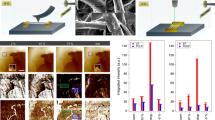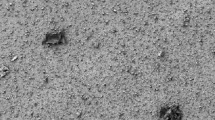Abstract
Industrial grade γ-ureidopropyltrimethoxysilane was adsorbed onto industrial grade E-glass fibres from toluene and carbon tetrachloride at 23 °C. The treated surfaces were characterised using thermogravimetry, diffuse reflectance Fourier transform IR spectroscopy, electron spectroscopy for chemical analysis, scanning electron microscopy and the zeta potential. When ureidosilane was deposited from toluene and CCl4, both of which have very low hydrogen-bonding ability, a ureido surface was obtained. The ureidosilane deposited from CCl4 hydrolysed at the surface and condensed to form a solvent-swollen Si–O–Si network. The ureidosilane deposited from toluene also hydrolysed at the E-glass surface. Condensation of the silane deposited from toluene was not apparent. Aluminium dissolved from the E-glass surface was condensed into the network of the silane deposited from CCl4. Aluminium was not detected at the surface of the samples with ureidosilane deposited from toluene.
Similar content being viewed by others
Author information
Authors and Affiliations
Additional information
Received: 10 November 2000 Accepted: 23 March 2001
Rights and permissions
About this article
Cite this article
Watson, H., Mikkola, P., Rosenholm, J. et al. Deposition characteristics of γ-ureidopropyltrimethoxysilane onto E-glass fibres using toluene and carbon tetrachloride as carrier solvents. Colloid Polym Sci 279, 1020–1028 (2001). https://doi.org/10.1007/s003960100542
Issue Date:
DOI: https://doi.org/10.1007/s003960100542




